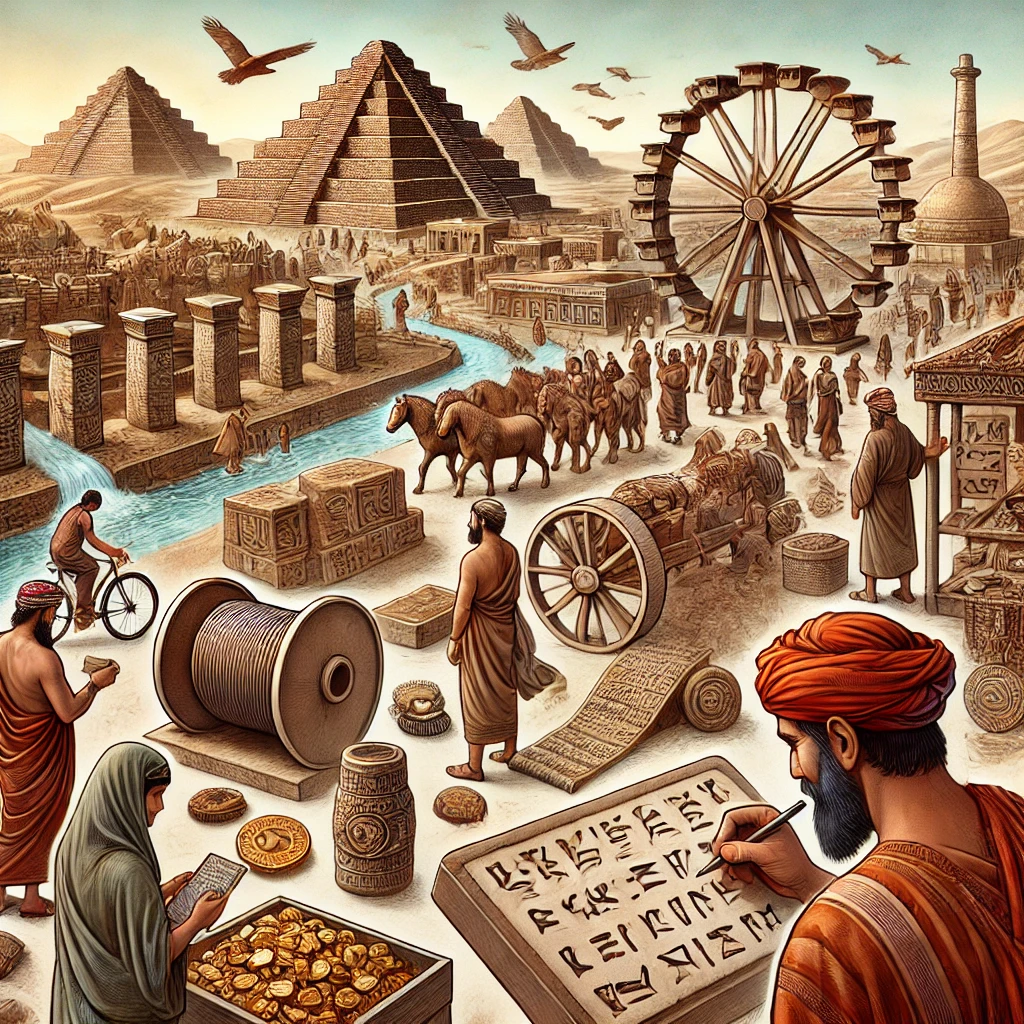The Sumerians innovations laid the foundation for many aspects of modern civilization. Their remarkable advancements in agriculture and irrigation systems revolutionized food production, enabling surplus harvests. Furthermore, the invention of writing and record-keeping marked a significant leap in communication and administration. Alongside these developments, their achievements in urban planning and architecture showcased their ability to create organized and sophisticated city environments. Together, these innovations underscore the Sumerians’ lasting impact on history and technology.
The advancements in agriculture and irrigation systems
The Sumerians made remarkable strides in agriculture, which significantly boosted their food production and societal development. Their innovations in farming techniques and irrigation systems set the foundation for future civilizations. Here are some key advancements:
- Irrigation Techniques: The Sumerians developed sophisticated canal systems to channel water from the Tigris and Euphrates rivers. This allowed them to farm arid land and ensured a stable water supply.
- Plowing Methods: They were among the first to use the plow, which increased efficiency in tilling the soil. This tool transformed agriculture and led to improved crop yields.
- Crop Rotation: To maintain soil fertility, the Sumerians practiced crop rotation, alternating between different crops to prevent nutrient depletion.
- Storage Solutions: Innovations such as granaries allowed for the long-term storage of surplus grains, which supported population growth and trade.
These Sumerians innovations in agriculture and irrigation not only enhanced their own society but also impacted future communities across Mesopotamia, laying the groundwork for agricultural practices that endure to this day.
The Invention of Writing and Record-Keeping
One of the most significant Sumerians innovations is the invention of writing, often credited as the foundation of recorded history. The Sumerians developed cuneiform script around 3200 BCE, which evolved from simple pictographs into a sophisticated system of symbols. This breakthrough had a far-reaching impact on civilization. Here’s how:
- Communication: Writing facilitated communication over long distances and across generations, allowing for the preservation of knowledge.
- Record-Keeping: The Sumerians used written records to document trade transactions, agricultural production, and legal matters, enhancing administrative efficiency.
- Literature: They created works like the Epic of Gilgamesh, showcasing their cultural richness and storytelling abilities.
| Aspect | Cuneiform Writing | Modern Writing |
|---|---|---|
| Medium | Clay tablets | Paper, digital platforms |
| Purpose | Record-keeping, laws, stories | Communication, expression |
| Languages Used | Sumerian, Akkadian | Various languages |
In summary, the Sumerians innovations in writing and record-keeping laid the groundwork for future civilizations, fundamentally transforming society by enabling communication and documentation that endure today.
The development of urban planning and architecture
The Sumerians innovations in urban planning and architecture laid the foundation for future civilizations. They transformed how cities were organized and constructed, and their strategies continue to influence modern urban design. Here are some key elements of their innovations:
- City Layout: Sumerians planned cities in a grid-like pattern, with distinct areas for residential, commercial, and religious activities. This organization facilitated navigation and improved community interactions.
- Ziggurats: These massive stepped structures served as temples and administrative buildings. They demonstrated advanced engineering techniques and held significant cultural importance.
- Infrastructure: Sumerians constructed roads, drainage systems, and defensive walls. This infrastructure supported public health and safety, promoting a more efficient urban environment.
- Materials: They utilized mud bricks and other local materials, which were abundant and provided durability. This practice allowed for sustainable construction.
The emphasis on city planning and architecture among Sumerians innovations laid the groundwork for complex societies and set the standard for future urban development. Their achievements not only changed their cities but also left a lasting legacy for generations to come.
Frequently Asked Questions
What were some key cultural innovations of the Sumerians?
The Sumerians made significant contributions to culture, which included the development of one of the world’s first writing systems called cuneiform. This form of writing used wedge-shaped marks on clay tablets and was essential for record-keeping, literature, and administration. Additionally, they established schools to educate scribes, developed extensive legal codes, and participated in polytheistic religious practices that influenced future civilizations. Their advances in arts, music, and architecture, exemplified by their ziggurats, underscored their cultural sophistication.
How did the Sumerians influence the development of laws?
The Sumerians are credited with laying the groundwork for legal systems by creating some of the earliest known law codes, including the famous Code of Ur-Nammu. This code outlined various laws concerning trade, property rights, and personal conduct, thus establishing a sense of order within their society. It set precedents for justice and governance that would inform subsequent civilizations, such as the Babylonian Empire, demonstrating the lasting impact of Sumerian legal innovations on future legal frameworks.
What technological advancements did the Sumerians achieve?
The Sumerians were pioneers in various technological advancements including the invention of the wheel, which revolutionized transport and trade. They also developed a sophisticated irrigation system that enabled agriculture to flourish in their arid environment, supporting larger populations. Additionally, they made significant strides in mathematics, introducing a sexagesimal number system that laid the foundations for geometry and astronomy. Their innovations in metallurgy and potter’s wheel further accelerated advancements in craftsmanship and art.
In what ways did Sumerian innovations impact later civilizations?
Sumerian innovations had a profound impact on future civilizations by fostering advancements in writing, governance, and engineering. The development of cuneiform was adopted by subsequent cultures, facilitating record-keeping and literature across the region. Their legal codes served as models for emerging societies, influencing laws in Babylon and beyond. Furthermore, their agricultural technologies, such as irrigation, enhanced food production, which allowed later civilizations to grow and sustain larger urban populations, illustrating the Sumerians’ crucial role in human development.


